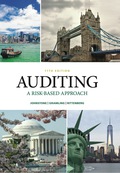
Concept explainers
a.
Introduction: In context of audit, materiality refers to the significance of an item or transaction in the books of accounts which have a direct bearing on the opinion of auditor and assessment of financial performance by users of financial statements.
To Define: Planning materiality and its practical application in audit.
b.
Introduction: Performance materiality refers to the significance assigned to an individual category of item(s) or transaction(s) by the auditor during the course of audit.
To define: Performance materiality and its practical application.
c.
Introduction: Posting materiality is that value of audit item or transaction which, if identified during audit, must be documented separately for subsequent consideration during the audit.
To define: Posting materiality and its application in audit.
d.
Introduction: Qualitative factors are those non-monetary considerations which are significant in the process of audit and have a direct bearing on
To Discuss: Impact of qualitative factors in quantitative materiality assessment.
Want to see the full answer?
Check out a sample textbook solution
Chapter 7 Solutions
EBK AUDITING: A RISK BASED-APPROACH
- Variable overhead:48000, fixed overhead:96000arrow_forwardCompute the manufacturing overhead rate for the year.arrow_forwardPortman Solutions paid out $42.5 million in total common dividends and reported $150.3 million of retained earnings at year-end. The prior year's retained earnings were $104.8 million. Assume that all dividends declared were actually paid. What was the net income for the year?arrow_forward
- accountingarrow_forwardNonearrow_forwardCrimson Technologies had $3,200,000 in sales for the 2023 year. The company earned 7% on each dollar of sales. The company turned over its assets 3.5 times in 2023. The firm had a debt ratio of 40% during the year. What was the return on stockholders' equity for 2023? Answerarrow_forward
 Auditing: A Risk Based-Approach (MindTap Course L...AccountingISBN:9781337619455Author:Karla M Johnstone, Audrey A. Gramling, Larry E. RittenbergPublisher:Cengage Learning
Auditing: A Risk Based-Approach (MindTap Course L...AccountingISBN:9781337619455Author:Karla M Johnstone, Audrey A. Gramling, Larry E. RittenbergPublisher:Cengage Learning Auditing: A Risk Based-Approach to Conducting a Q...AccountingISBN:9781305080577Author:Karla M Johnstone, Audrey A. Gramling, Larry E. RittenbergPublisher:South-Western College Pub
Auditing: A Risk Based-Approach to Conducting a Q...AccountingISBN:9781305080577Author:Karla M Johnstone, Audrey A. Gramling, Larry E. RittenbergPublisher:South-Western College Pub

